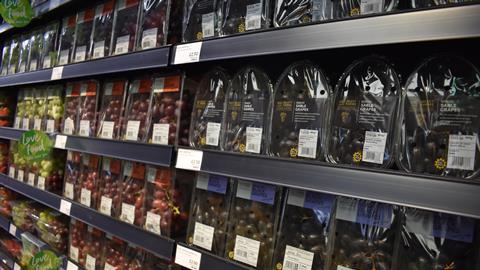Of all the perishable cargoes affected by the Panama Canal drought, the Red Sea crisis, and infrastructure issues in South Africa, table grapes have been worst hit. And now, market prices may be about to fall
In the final paragraph of his second market update of the year, Capespan North America President Mark Greenberg reported rumours of what he saw as an unnecessary drop in market pricing come the end of January. “The market is reporting a likely price level of US$26 per box when the market is currently averaging US$10 per box more,” he said and added that: “Even considering an increase in arrivals from Chile in the coming weeks, one must wonder why prices would soften so suddenly, especially given the early end of Ica’s [Peru] shipping season. Programme prices may be in that range at that time… but non-programmed sales?” he asks rhetorically.
If the pricing speculation is accurate, it is indeed an interesting development. Historically, the marketing problems Chile has faced in the US with its table grapes have generally resulted in the retail pricing point dropping too slowly ahead of heavy volumes of fruit that arrive in early February.
The criticism is that shippers have been reactive to price rather than proactive in anticipation. This lack of foresight has caused sales to stagnate and led to stock accumulation, congestion and bottlenecks along the logistics chain and, eventually, the re-packing of old stock. That means the loss of fruit that would certainly have been good enough, had it been sold earlier.
Why not, therefore, try the opposite? The theory being that dropping the price early will motivate sales, which will result in faster throughput, less coldstore dwell time, and a more efficient and therefore less costly supply chain. Once the strategy starts to bear fruit, shippers can even start thinking about raising prices, which is the polar opposite of what has happened since, well, ever…
All sales-related variables are aligned favourably for Chilean grape shippers this season: Peru was early and will be over by the time peak Chilean volumes arrive; while Chilean volumes, the majority of which are newer, more resilient varieties, are forecast to be a tick higher last season. There is no other direct competition.
It would be a shame therefore to see shippers once again inhibit demand when sales momentum is required, because they held out for too high a price early on.
Logistics looms large
There is a not insignificant threat to the storyline. Logistics, the single material variable on which the above scenario is contingent, has the ability to hole the marketing effort below the waterline. As a direct result of the reduction in Panama Canal transits, this season will be the first that more Chilean table grapes will be shipped to the US from Chile on carrier services than in specialised reefers.
Given that US landside logistics (particularly discharging and fumigation) in the Delaware River are so oriented around the specialised reefer supply chain, it would be reasonable to anticipate a number of logistical headaches as a consequence of the modal shift. On the other hand, shippers, carriers and terminal handlers have had several months to prepare for all eventualities.
Meanwhile, after a difficult couple of years, the stage is set for a bumper season for South African grape shippers. Fruit quality is reported to be excellent, the main destination markets in the EU are ‘empty’ and there will be limited competition from Peru and Chile.
What Indian grape shippers do is contingent on a resolution to the Red Sea crisis. Unless they can persuade a friendly carrier to navigate through Suez via the Gulf of Aden, they face a voyage to market of six weeks plus, and a US$4,000 per-container surcharge for the privilege of taking the scenic route to Europe around the Cape of Good Hope. It may not be worth the risk on either count.
A risk of derailment
As with Chile, logistics threatens to derail the best laid plans. In South Africa’s case, there are longstanding problems in Cape Town’s container port that could spoil the party. It looked very promising last November when a statement issued jointly by South African logistics parastatal Transnet and fruit industry bodies Hortgro, SATI and FPEF outlined the port’s plans to improve the operational throughput of fruit.
At the time, Transnet management committed to better planning, sourcing additional equipment, on-site maintenance capacity, and increasing availability of spares. It presented an eight-point plan to improve efficiencies, which included optimising the port as a delivery platform, combating adverse weather conditions, improving truck operations, optimising marine services, improving information sharing and port operations visibility, terminal equipment and port infrastructure, people management, and managing the immediate crisis.
Fine words. But since November, things have gone downhill fast. Fruit is currently being cleared for export but has to be held in coldstores because the port is unable to load the containers onto ships. Last week, table grape industry body SATI said it was continuing to engage actively with Transnet and government role-players at the highest levels to intervene and limit the impact of the current season’s challenges. The carriers meanwhile have started strategically diverting some vessels to Port Elizabeth to reduce the pressure. However, this forces exporters to truck product 750km instead of directing it to the Port of Cape Town. Not only is there a significant cost involved, but there is also a shortage of trucks.
In the Port of Cape Town, the smaller reefer vessel has a competitive advantage over the containerships. The reefer can load and discharge in the more sheltered waters of FPT than the more exposed and wind-affected container and multipurpose terminals. The carriers can do very little when the Cape Doctor blows, other than drop anchor in the roads and wait. Or bypass the port completely. Coupled to poor operational performance, the wind disruption has been recorded as 517 hours lost between week 45 and week three. This is 214 hours higher than in the same period last year.
Unsurprisingly under the circumstances, the Seatrade/Cool Carriers reefer alliance service to the UK, northern Europe and Baltic region continues to be oversubscribed. Meanwhile, the European grape market remains undersupplied and pricing strong. How much this will change when the accumulation of unshipped containerised South African fruit inundates markets in early February remains to be seen.







